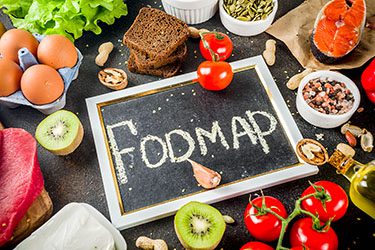
This blog originally ran in August 2019 and features registered dietitian and certified diabetes educator Lori Lehnert as a special guest blogger.
Abdominal pain, bloating, constant gassiness, diarrhea and constipation are not exactly everyone’s favorite topics to discuss in public. However, they are things you should be talking about with your healthcare team if you experience these symptoms—especially if they interfere with your daily activities and quality of life. While many different medical problems could be the culprit for your symptoms, one common diagnosis is Irritable Bowel Syndrome (IBS). Considered a diagnosis of exclusion, meaning that your doctor rules out other potential causes for your issues first through various tests, IBS affects 10-15% of the world’s population. The good news though, is that over the last 15 years, a dietary treatment, the Low FODMAP diet, has been shown to significantly improve symptoms in over 70% of those who try the diet.
So, what exactly is a FODMAP? FODMAPS stands for Fermentable Oligosaccharides Disaccharides Monosaccharides And Polyols. These are groups of short-chain carbohydrates that are not easy to digest and are linked to high levels of gas, bloating, diarrhea, constipation and stomach pain in some individuals. Examples of common High FODMAP foods include asparagus, garlic, onion, cauliflower, apples, pears, watermelon, cow and soy milk, yogurt, wheat, rye, barley, high fructose corn syrup, sorbitol, xylitol, agave and honey.
The Low FODMAP diet is NOT a long-term diet and it is not a weight-loss diet—it is an elimination diet, done in phases with the goal of determining which foods are the culprits and gradually adding back in those that do not cause the symptoms. The first step is to eliminate High FODMAP foods and substitute Low ones for 2-6 weeks. Once adequate relief is found during those 2-6 weeks, it is time to move on to the next phase. In the reintroduction phase, you gradually introduce High FODMAP foods back into the diet, one group at a time, one food item at a time and gradually, increase portion sizes of each food over several days per item. It is in this phase that you begin to identify which items are well-tolerated and which items are making symptoms worse. The final phase is personalization: If symptoms return when reintroducing an item, then adjust portion sizes to find an acceptable level or avoidance of that item. Those groups that do not increase symptoms are added back into the diet.
Are you wondering if a Low FODMAP diet may be the answer to your gastrointestinal (GI) issues? Well, there are a few key things to keep in mind. First, make sure you have met with your healthcare provider to discuss your concerns and symptoms. It is important to have all other possible sources for your symptoms investigated first before assuming that it’s IBS. Additionally, FODMAPs are not to be eliminated completely—they are very beneficial prebiotics that help build good bacteria in our GI tract. The goal is to establish a tolerable level of FODMAP foods to allow for their intake without eliminating all of them.
Altogether, the process can take up to 6 months to fully complete, so consideration to how this will fit into your life over the next few months is important as well. For these reasons, it is recommended that you work with your healthcare practitioner and a registered dietitian to determine if this step is the right one for you and to work with you through the entire process to maximize your success.
Read Lori’s thoughts on other popular nutrition trends, like keto, whole foods and more.
Sources:
Monash University – About FODMAPS and IBS; accessed August 25, 2019.
International Foundation for Gastrointestinal Disorders; accessed August 25, 2019.



Love my TOPS family I have lost 140 lbs been member since 2006 best plan toloose weight .
That’s awesome, Rose!
Last night I made chicken veggie soup with broccoli and cauliflower, sweet pepper and onions, garlic, low sodium broth and rice and quinoa. Had about a cup and half and then watermelon for dessert. This morning loose bowels. Remembered reading your article and think I may have found the reason. Printed out the article and will try and moderate my consumption of high FODMAP foods at the same time.
thank you for all this information, I suffer from all of the above and will be testing which foods I need to give up or limit.
Very interesting article. Recently had large portion of small, organic, seedless watermelon from farm stand & spent the night going to the bathroom. Was all but dehydrated by morning which shocked me. Now I understand. A question … will taking a strong probiotic with 11+ active cultures help with preventing this type of reaction?
Thanks for reading, Barb! Since we can only provide general information and can’t speak to anyone’s unique situation, we always urge members to check with a licensed healthcare professional before trying a new supplement.